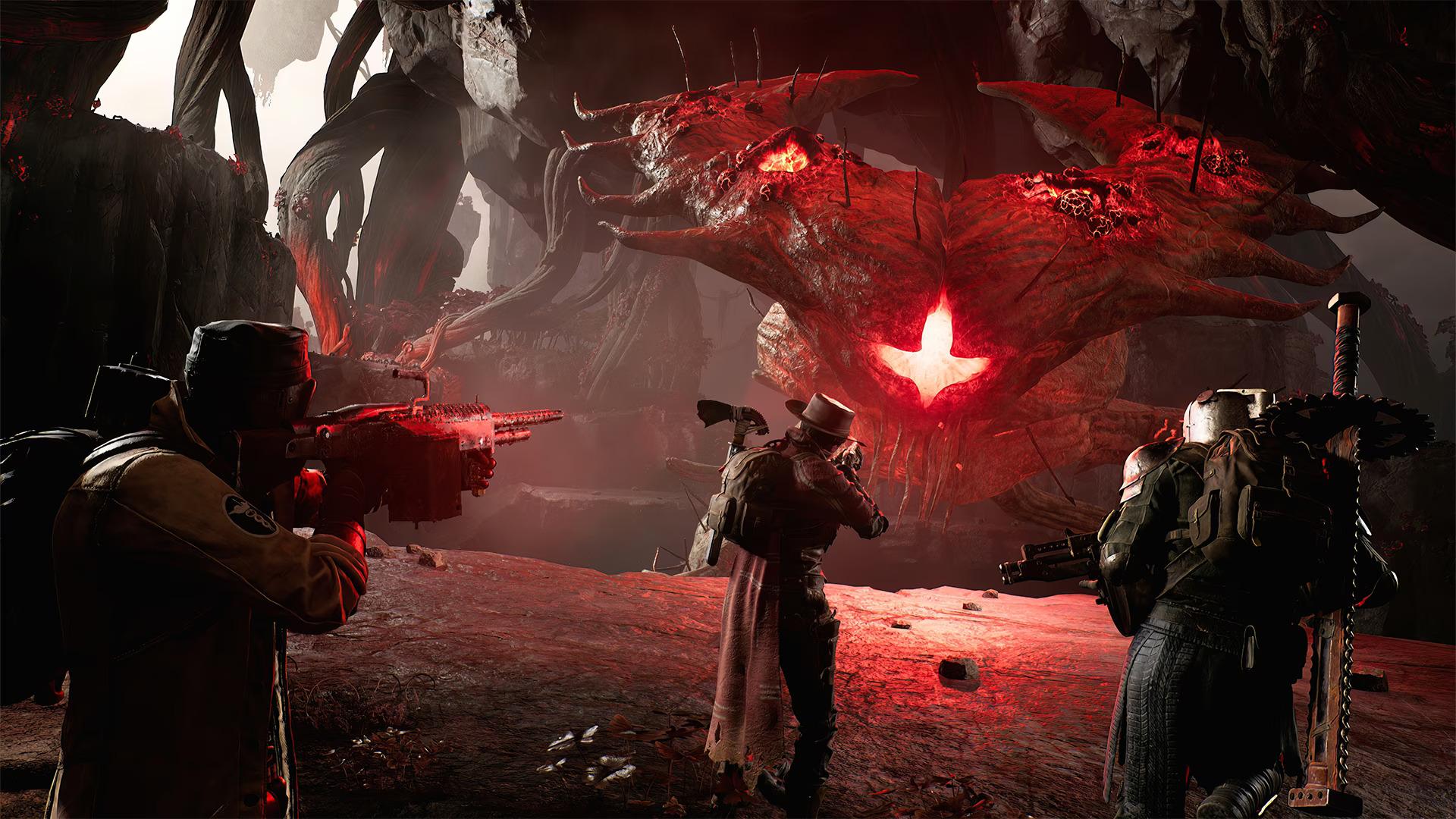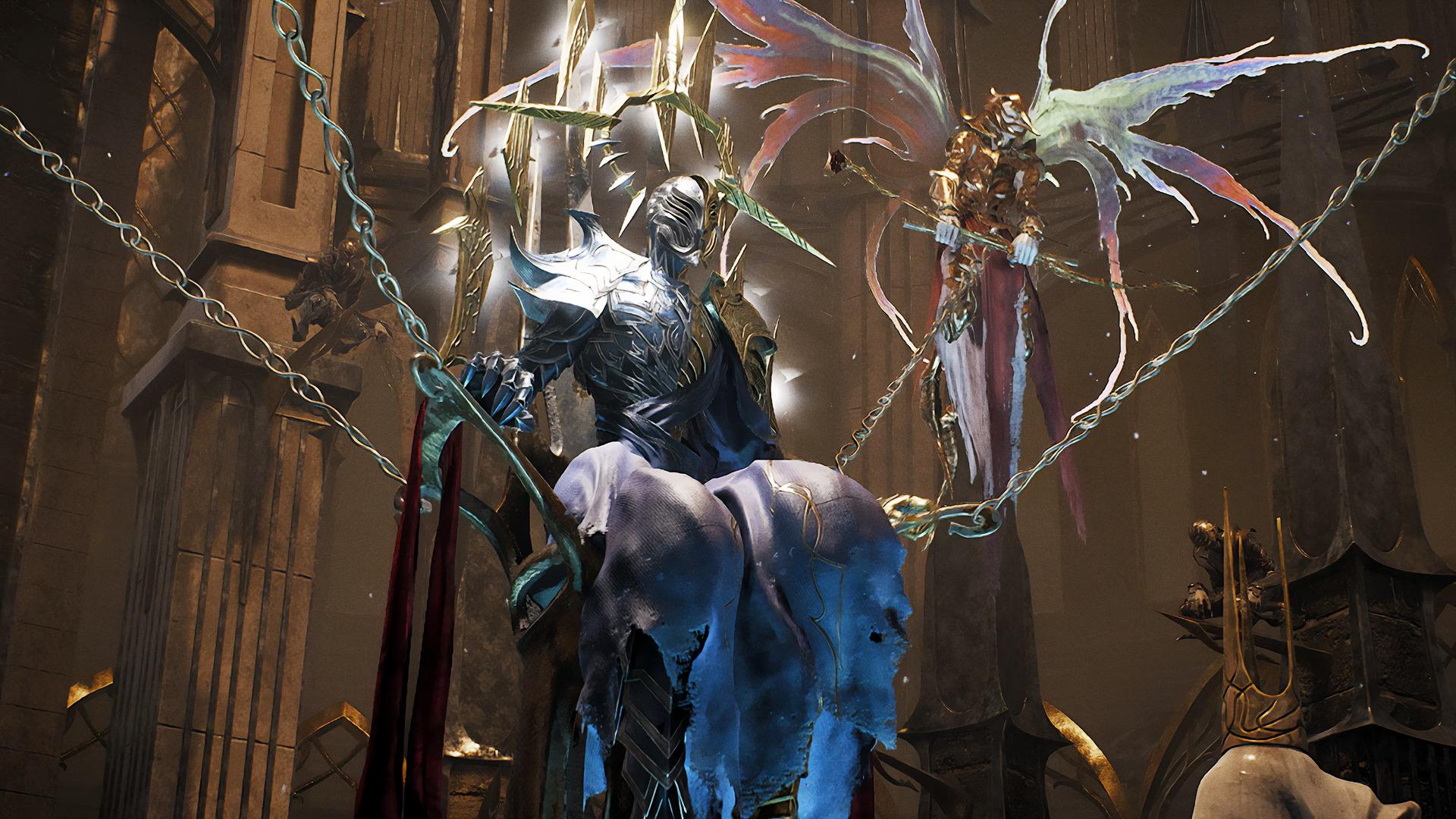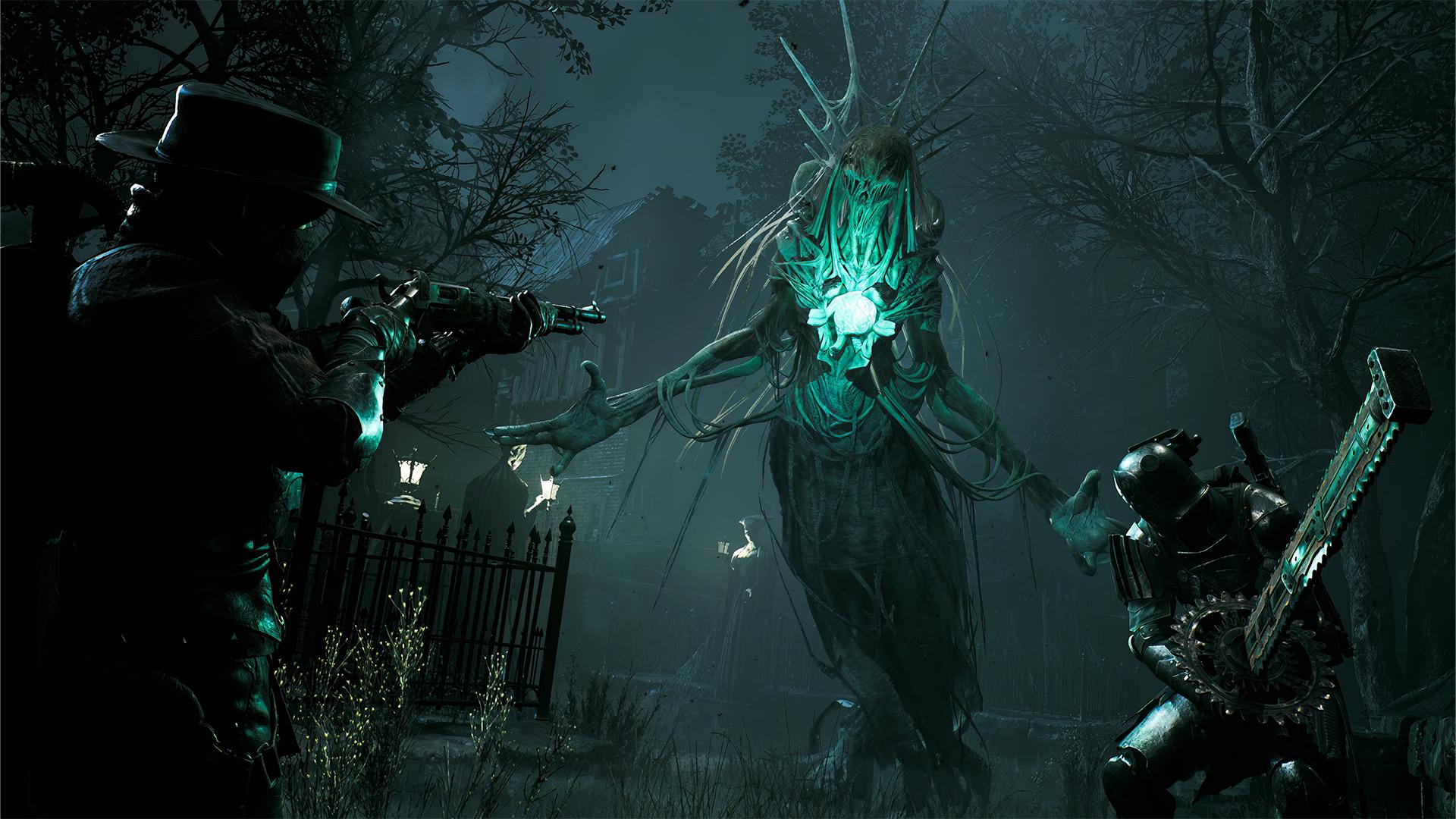The Ultimate Gameplay Preview
Written by - Livid
Updated: July 12, 2023
|
Posted: June 13, 2023

WHAT IS REMNANT 2?
There’s no doubt that Remnant 2 will continue to build upon the foundation of Remnant: From the Ashes, but for new players that may not have had the chance to play that first game, I think it’s important we establish what Remnant 2 is… and what it isn’t.
Remnant 2 is first and foremost a third-person souls-like… with guns. The game releases on July 25th, 2023, with all of the trappings of classic Souls games, including challenging enemies, an all-important dodge mechanic, the collection of a resource in order to unlock powerful upgrades, and of course, the high level of difficulty synonymous with the genre.
What you also might not realize about the Remnant series is that while everyone starts their adventures from a very specific “square one,” the game is designed around replaying the story with the same character multiple times.
The bosses, dungeons, and even sometimes the enemy composition you’ll encounter will be randomized, and to collect all of the weapons and rewards available in the game, you’ll need to play through Remnant 2 multiple times, sometimes even on different difficulties.
You’ll unlock new archetypes, gear, weapons, and traits, slowly building up an arsenal that’ll transfer with you from playthrough to playthrough, allowing you to build your character exactly how you want.
Quality of Life Improvements
Remnant: From the Ashes may be one of Livid’s all-time favorite games, but it was by no means a perfect game. Because Remnant 2 is a sequel, I think we need to highlight some notable quality of life improvements.
For starters, stamina will no longer be consumed outside of combat. While this means exploration won’t feel like a complete slog when traversing the world and exploring secrets, stamina will be a resource you need to more tightly manage within fights.
Second, world generation has been ramped up and feeds into the game’s overall replayability. In Remnant: From the Ashes, there were only a handful of tilesets that could be strung together for some variation, but all enemies in that world, along with boss fights and secrets, would always play out the same way. Remnant 2 flips that on its head. The story is no longer one linear path, and while there is a common thread that runs through the entire game, each biome has multiple self-contained stories that can generate when you load in. This means you and your friends could all load into the game separately, all get placed in Yaesha for your first biome, but each one could end up with a completely different self-contained story.
This even goes a step further with the introduction of something called injectables; special encounters or mini-dungeon elements that can be generated onto any of the major or minor dungeons in the game. A breakable wall that opens up into an arena in one person’s game might be a solid wall with nothing behind it in another. Pathways, enemies, and more all get randomized with every playthrough, making no two runs play out the same way.
This level of depth means navigating the world becomes that much more important, and quite a few players found the map in Remnant From the Ashes to be unclear at times. The Remnant 2 map has been completely overhauled. It’s now fully 3D and extremely clear on where terrain changes height, where an object in your vision can be collected, and even where objectives are located. Hovering over any of these icons on your map will also display important contextual information.



The UI has also received a substantial facelift. Health, debuff, and buff information now display prominently at the bottom center of the screen. If you’re ever unsure of a particular effect, you’ll be able to hover over these icons in the top left of your character screen to see exactly what is happening to your character.
You’ll also might have noticed that when you take damage in Remnant 2, 50% of that damage becomes gray health. This is now health that recovers slowly over time. The cool thing? There are now items, methods, and even full builds that can play into this gray health system, regenerating it more quickly or leveraging it for other benefits.
In the same vein, you’ll need to know if you are prepared or not for the environment you are entering, something that was a pain point for many players back in Remnant From the Ashes. Above your minimap, next to the name of the zone you are in, you’ll see a number. This tells you the power level of the enemies in the region. If your gear level is below that number, the challenges ahead will be significantly more difficult, and you’ll need to upgrade your gear in order to keep progressing.
Fundamental Shift in Systems
Along with these major quality-of-life updates comes numerous system overhauls that aim to take build crafting and play styles to entirely new levels while also ensuring difficulty remains relevant.
In Remnant From the Ashes, armor sets had distinct bonuses tied to them based on if you were utilizing 1, 2, or the full 3 pieces. This largely restricted a player’s decisions when it came to build crafting for several reasons.
Armor sets were also part of specific weight classes that included light, medium, heavy, and super heavy. These not only directly influenced how much damage they naturally mitigated in combat but also had a direct impact on your dodge mechanic. Light and medium armor offered distinctly better i-frames than heavy armor, while super heavy saw your character flopping to the ground with what you could barely call a dodge.
Because of this, the bonuses that were associated with these sets of armors often directly correlated with the weight and armor value, essentially pigeonholing players into specific progression playstyles.
Armor weight, coupled with rigid set bonuses, restricted build crafting immensely. Sure, there were trinkets that allowed you to take advantage of mixing two sets, but most of the time, a full set was vastly superior to a combination. This also meant you couldn’t just wear what looked cool, as doing so would likely impact or even ruin your build.
While weight classes are still a thing on each set of armor in Remnant 2, you’ll be glad to know that set bonuses are not, and those cool effects didn’t vanish. Instead, the brand-new archetype system aims to not only fill the void but massively expand its horizons.
ARCHETYPES
What Are They and How Do They Work?
Humans aren’t magical in the world of Remnant, but they can do magical things when empowered with the right object.
The new archetype system, showcased in this menu here, allows you to equip magical objects on either the left, the prime archetype, or right side, the sub-archetype. In this case, the iron cylinder is equipped on the left, granting Gunslinger. On the right, the steel enswell is slotted, granting Challenger. These and many more items you collect during your various playthroughs will dictate which archetypes you have at your disposal, and each comes with its own unique trait, perks, and skills. While they can’t be changed, they can be improved. But let’s go over exactly what each of these things are.
Let’s start with signature archetype traits, indicated by these two sections just under the item slots. Every archetype has one, and initially, it’s only available when its specific item is equipped. You won’t see these signature traits by default on the universal trait page, but luckily, that won’t always be the case.
Each archetype in Remnant 2 can be leveled up through experience, and as you increase your item’s level, these unique traits will automatically level up for free until you cap out at level 10.
This is important for several reasons. Unlike the first game, Remnant 2 will have limited trait points to use. You won’t be able to max out every single stat and become an unstoppable killing machine. Luckily, we were able to confirm with the developers that players will be able to respec their traits at any time to experiment with entirely different builds. This means a signature trait is effectively a free, fully leveled trait that your build can tap into for extremely potent effects.
When your archetype item reaches max level, that trait then becomes unlocked for any archetype to use on that aforementioned trait page. The catch? Signature traits being used via that trait page will require you to spend trait points to use it. This means not only can signature trait builds become a thing, but if you put in the time and effort to unlock them, the variety these traits can bring to other archetypes can be substantial.
Archetype Perks
Traits aren’t the only thing improved when you level up your archetypes. This brings us to archetype perks.
On the far left and far right side of this menu, beneath the traits, you’ll see four fixed perk slots. Every single archetype will have unique, unchangeable perks that fill four different categories.
- Damage perks: As the name suggests, scale the damage output of your character. This includes individual augments to things like ranged buffs, melee buffs, mod power buffs, and skill damage buffs.
- Team perks: Affect all allies, whether you are playing alone or in a group. This includes player allies, NPCs, or summons you pick up along the way. You can expect to see buffs here to team defense, shared healing, or even increased ammo drops.
- Utility perks: Provide quality of life effects. They are typically small buffs that blend well with the rest of the archetype’s gameplay elements. For example, if your archetype relies on sprinting and evading, a utility perk might help reduce your overall stamina costs or consumption.
- Relic perks: These are temporary effects that become active for a short duration whenever you use a relic. Relics were previously called Dragonhearts in Remnant and are used to heal on limited charges. The buffs in this category are potent and can turn the tide of an encounter, but they are directly limited by how many relic charges you have left. Think of something like the Believer armor set bonus in Remnant, where using a Dragonheart would significantly buff you and your allies’ damage for 30 seconds. The relic perks are essentially that but moved to a relic slot and not bound to any specific armor.
There is one more perk we have to talk about, the prime perk, which is always dictated by the archetype item in your left slot. These are the core identity of an archetype and provide a significant benefit that no other archetype or item can provide. For example, the Gunslinger’s prime perk is Loaded, which makes it so that when activating any Gunslinger skill, both of your weapons will instantly reload and gain infinite reserve ammo for 15 seconds, allowing you to unleash a barrage of attacks on your target.
All perks are unlocked sequentially as you level up your archetype, including your signature perk. Levels 1, 2, 3, and 4 unlock each perk in order, with level 5 being the signature perk. From levels 6-10, this process starts over, and every perk gets enhanced. It’s a really cool system that rewards time investment.
Archetype Skills
Let’s talk about archetype skills, which are the three dramatically illustrated icons directly beneath each item slot and are special abilities that can only be used by that archetype. While there are three skills per class, you can only have one active at a time. However, you can actively switch between any of your unlocked skills as long as you are out of combat.
These skills operate on a cooldown system rather than something like mod power buildup, which is still its own system. The intention here is to balance their use and make skills feel more strategic in terms of when and where you use them. They have long cooldowns to ensure that their usage is carefully considered.

Additionally, whatever archetype is slotted in the prime archetype slot will have enhanced skills. This can mean anything from more potent DPS values to multiple charges for certain skills. The decision to slot an item in your primary or secondary slot will have a significant impact on your playstyle. This is another fantastic addition to the game that adds depth and variety.
If it isn’t clear by this point, you can have dual archetypes. You’ll quickly realize that Remnant is effectively evolving from having only two active abilities via mod charges to having four active abilities: two from skills and two from mod charges. This opens up build crafting possibilities and allows for even more unique play styles.
Dual Archetypes
In Remnant 2, when players combine two archetypes, they effectively create a “class.” The class name is generated based on the archetypes slotted in the two slots, allowing other players to immediately recognize your setup and playstyle.
For example, if the Gunslinger archetype is slotted in the prime archetype slot on the left and the Challenger archetype is slotted in the secondary archetype slot on the right, the game will generate a predetermined name for that class. In this case, it would be called “Mercenary.” Regardless of the side on which these two archetypes are placed, when combined, they will always be known as the Mercenary class.

The game also takes into account the main perk of the prime archetype and adds it in front of the class name. In this example, it would be “Loaded Mercenary.” This allows players to immediately recognize that your prime slot is Gunslinger and your secondary slot is Challenger, giving them an idea of what to expect from your playstyle.
Every class combination has its own unique name, so there should never be any confusion once players are experienced enough. This system is designed to improve multiplayer experiences by providing clear information about each player’s setup.
Starting Archetypes
In Remnant 2, the archetypes you choose from can be seen as classes. When starting a new game in Remnant from the Ashes, players had to pick between three starting classes: the Scrapper, the Ex-Cultist, and the Hunter. Each class came with a specific armor set with a set bonus, a distinct primary, secondary, and melee weapon, a special mod, and a starting perk. However, in the game, players could find pieces of these items from various sources throughout their journey.
In Remnant 2, these starting options are represented as archetypes. The choices have expanded, and players will receive a trademark armor set that is not tied to any set bonus, a unique primary, secondary, and melee weapon, and a specific archetype item. As mentioned before, the archetype item replaces the armor set bonuses and provides a range of perks, skills, and a signature archetype trait tied to each item.
It’s important to note that while your starting archetype choice impacts your initial playstyle and build, everything within each starting archetype can still be found somewhere in the world of Remnant. However, it may not be readily available when you want it, so it’s still advisable to choose your starting archetype wisely.
GUNSLINGER
The Gunslinger archetype, activated by slotting the Iron Cylinder item, is the ideal class for players aiming for high fire rate, weapon handling, and overall ammo efficiency. It is the class that pure damage enthusiasts will likely gravitate towards, as everything about it is geared towards maximizing DPS.
The special archetype trait, Ammo Reserves, allows the class to increase ammo reserves up to 100%, ensuring that no combination of skills or weapons will leave you running out of ammo.
Considering this trait, it’s no surprise that all the perks for the Gunslinger archetype lean into maximizing overall DPS:
- Swift Shot: Increases fire rate, ranged damage, and critical chance for all firearms.
- Posse Up: Awards additional ammo per play and causes ammo boxes to drop additional ammo on the ground.
- Quick Hands: Increases firearm reload speed and doubles it if the magazine is empty.
- Sleight of Hand: Increases your overall ranged damage and reloads your firearm whenever a relic is used.
The class’s prime perk, Loaded, reloads both of your weapons and grants you infinite ammo reserves for 15 seconds whenever you activate any Gunslinger skill. This keeps your ammo economy untouched while allowing you to keep firing.



Now let’s discuss the three skills of the Gunslinger archetype:
1. Quick Draw: Pulls out your sidearm and unloads a certain amount of rounds evenly among all enemies in view. Holding and releasing the skill allows you to aim the weapon manually and turns it into a super shot, guaranteeing a critical hit with 6x damage. This skill has a relatively short cooldown and its flexibility with hitting multiple targets or focusing on a single large target makes it hard to pass up for any build.
2. Sidewinder: When activated, it increases ADS (Aim Down Sights) movement speed and weapon draw/swap speeds. Additionally, you’ll fully reload weapons just by cycling between them, granting you ridiculous amounts of sustained damage.
3. Bulletstorm: This skill makes every firearm fully automatic, boosts fire rate, and ramps up reload speed. It even grants special perks for bows and crossbows.
If you’re looking for a DPS class that rains lead like no other, then the Gunslinger archetype may just be the class for you. Its focus on high damage output, increased ammo reserves, and powerful skills make it a formidable choice on the battlefield.
HANDLER
The Handler archetype in Remnant 2 is activated by equipping the Silent Whistle and is the ideal choice for players who enjoy playing solo or heavily augmenting their teammates in battle. The Handler traverses the various worlds with a trusty canine companion, and the class revolves around enhancing teamwork and survivability.
One notable feature is that your dog companion can never truly die. When incapacitated, the dog just needs a bit of encouragement to get back in the fight. Being near the dog during combat starts health regeneration for him, and giving him a few pats further accelerates the regeneration process.
The archetype trait, Kinship, reduces friendly fire damage both dealt and received by up to 80%. This reduction is critical for ensuring the survival of you, your pet, and your team, especially when it comes to explosive weapons.
The Handler is a jack-of-all-trades class, and this versatility is apparent when looking at the wide variety of stat boosts provided by perks:
1. Pack Hunter: Grants a sizable boost to ranged and skill damage, which is further increased when you are within a certain range of your furry friend.
2. Spirit of the Wolf: Increases movement speed for you and your allies, and reduces the stamina cost of all allied actions.
3. Teamwork: Boosts the Handler and companion’s revive speed by a massive amount. When reviving, you take less damage, and your companion is slightly more difficult to stagger.
4. Best Friend: Fully heals your companion and boosts their damage and damage resistance whenever you consume a relic charge.
The prime perk, Bonded, is a game-changer for both solo players and teams. When you’re taken down, your companion will attempt to revive you up to 50% of your maximum health. This can be used on allies as well, as long as they still have at least 1 relic charge remaining. Your trusty pooch will be there to help out even if an ally is downed out in the open.



In addition to everything your companion already does, you can issue commands like attack, heel to your side, or guard an ally. The real star of the show is becoming apparent here.
The class skills are replaced by behaviors, which change the function of your companion and grant them unique passive buffs. Single tapping the behavior will have your companion engage enemies at the targeted location, while double tapping will have the companion return to the Handler’s side. Each behavior is accompanied by a special howl that brings additional depth to the behavior.
1. Guard Dog: Causes your companion to generate more threat and take less damage, drawing aggro away from you and teammates. Holding the behavior triggers a howl that generates increased threat and reduces the damage all allies take in a large area of effect (AoE).
2. Support Dog: Continuously heals allies near the companion in a small AoE. When held, the howl rapidly heals and boosts the movement speed of all allies in a large AoE.
3. Attack Dog: Massively increases your companion’s damage. When held, the howl also massively boosts the damage for you and all allies in a large AoE.
The Handler is an outstanding solo or party assist class, particularly suited for players who lean more toward support roles. Having a furry friend as a constant companion is definitely an added bonus.
CHALLENGER
The third archetype we’ll be discussing is the Challenger, activated by slotting the Steel Enswell item. The Challenger class allows players to make more efficient use of heavier armor sets, reducing stamina consumption and bolstering both your own and your team’s damage and defenses. This archetype is geared towards reducing enemy damage while amplifying your own stats based on the overall density of threats in front of you.
The special archetype trait, Strong Back, reduces your overall encumbrance by 1 per level, allowing armor sets to function as if they were of lower weight classes. This trait enables you to take advantage of the damage mitigation of heavier sets.
The perks associated with the Challenger class all support the use of heavier armor sets and reducing enemy damage:
1. Close Quarters: Boosts your ranged and melee damage based on the number of enemies within a set distance.
2. Intimidating Presence: Reduces the damage all enemies deal within a fixed radius after using a Challenger skill. The potency of this reduction increases based on the number of enemies affected.
3. Powerlifter: Reduces the stamina cost and stamina regeneration delay by 50% for all weight brackets.
4. Face of Danger: Grants you stacks of Bulwark and increased damage whenever you use a relic within range of an enemy. This allows you to better fight off hordes that catch you off guard.
The prime perk for the Challenger class is Die Hard. It gives the Challenger a second wind when receiving fatal damage, slamming the ground, becoming invulnerable for a short duration, and regenerating maximum health. However, this perk has a very long cooldown.



Now let’s talk about the three skills associated with the Challenger class:
1. War Stomp: Creates a high-impact tremor that deals damage and additional stagger in a forward cone. It also deals damage in all directions at point-blank range.
2. Juggernaut: The player becomes nearly unstoppable, gaining Bulwark, increased movement and melee speed, and increased melee damage. Stagger damage to the player is also reduced by 1 level.
3. Rampage: The Challenger enters a heightened state of battle, increasing fire rate, reload speed, and movement speed. Dealing high damage to enemies grants 1 stack of Rage, which increases ranged damage by a fixed amount per stack. Upon reaching 10 stacks, the Challenger goes berserk, reloading their current firearm and doubling the effects of Rampage for a moderate duration.
The Challenger class is designed for players who enjoy being up close and personal with enemy hordes, especially melee users. It allows you to draw their aggro, knock them down, and keep your allies protected in the process.
CHARACTER POWER
Relics
In Remnant 2, relics have undergone a significant overhaul and play a fundamental role in your build. While in Remnant from the Ashes they were known as Dragon Hearts and mainly used for healing, relics in Remnant 2 encompass a wider variety of items that can greatly impact your gameplay.
Dragon Hearts still exist as a type of relic, but there are many more relics that you can discover as you explore the various worlds. These relics can provide different effects, ranging from burst heals and heals over time to defensive and stat-augmenting bonuses when activated.
Additionally, your relic slot now has three relic fragment slots. These relic fragments can be obtained from various sources, such as challenging encounters, special enemies, and ornate chests. By adding these fragments to your relics, you can apply new effects whenever a relic is consumed. These effects can include boosting your critical damage, applying shields, and more. Similar to the jewelry system, you can change out these fragments at any time to suit your needs.
One of the cool aspects of this system is that you don’t need to manually upgrade these relics. As you increase your gear level, fragments of the same type will start dropping with more potent stats. The game will automatically replace your old fragments with the highest stat value you’ve acquired, turning the old fragment into relic dust. Relic dust can then be used to roll for chances at higher stat fragments at a new vendor.
Overall, the relic system in Remnant 2 offers more depth and customization options for players, allowing them to tailor their gameplay experience and build by combining different relics and fragments to suit their playstyle.
Traits
In Remnant 2, the trait system has been overhauled to provide more meaningful choices and build diversity. You can no longer fully level up every single trait and become overpowered. Instead, you need to strategically invest a limited amount of trait points into the traits that matter most to your build. This change adds challenge and ensures that your character’s strengths and weaknesses are more pronounced.
The good news is that you can fully respec your trait points at any time without any hidden resource costs or rare items. This flexibility allows you to experiment and find the build that suits your playstyle best. It also makes builds more meaningful, particularly when tackling the hardest difficulties.
At the beginning of the game, all players will start with four basic traits already unlocked:
- Vigor: Increases your maximum health.
- Endurance: Increases your total stamina.
- Spirit: Increases your mod power generation rate as you deal damage.
- Expertise: A new trait that helps reduce your skill cooldowns.
The developers have made the decision to remove flat damage perks from the game because they were considered boring and often mandatory for every build. Instead, traits are designed to focus on important decisions that influence your stats and play a crucial role in making your build function effectively.
You can acquire traits from defeating bosses, completing quests, and solving various puzzles throughout the world. Trait points, on the other hand, are obtained by killing bosses, finding books on the ground, and by defeating aberrations, which are special super elites that randomly spawn and offer their own unique rewards.
This revamped trait system encourages players to carefully consider their choices, specialize their character, and adapt their build to overcome the challenges they face. It adds depth and strategy to character progression, allowing for a more engaging and rewarding gameplay experience.
Weapons and Gear
In Remnant 2, melee combat has received a significant upgrade to address previous complaints that it didn’t feel viable. While Remnant is primarily a gun-based game, the developers have made efforts to make melee weapons and builds more satisfying and viable. There are now more melee weapons available, and the fluidity of melee attacks has been improved. Multiple new styles of melee weapons, such as greatswords and steel katanas, have been introduced, along with a variety of new attack animations.
To further enhance the melee experience, archetypes like the Challenger and new traits that heavily focus on melee combat have been added. These changes aim to provide a more satisfying “souls-like” melee experience for players who prefer that playstyle.
The trailers and gameplay footage have showcased a wide range of new weapons, including:
- AS-10 “Bulldog”: A fully automatic, drum-fed shotgun with devastating firepower.
- XMG57 “Bonesaw”: A light machine gun with an incredibly high-capacity magazine that becomes more accurate the longer it fires, although it has a long reload time.
- Bow and Arrow: A brand new weapon type introduced in Remnant 2.
- New grenade launcher: Designed for explosive attacks against enemies.
- Quicker firing Mosin-like rifle: Offers faster and more precise shots.
- Iron Greatsword: A new melee weapon with an exceptional attack animation, resembling a giant steel saw.
- Returning weapons like SMGs, machine pistols, repeater pistols, hunting rifles, assault rifles, and more.
The Twisted Arbalest is a rework of the popular Ricochet Rifle from the first game. Its attacks can bounce up to five enemies, and the featured mod, Guardian’s Call, allows you to call down high-damaging swords on marked targets. This impressive weapon is expected to be a staple in many builds.



Additionally, Brabus, the bandit boss from Remnant: From the Ashes, is now an arms dealer right from the start in Ward 13. You can purchase a wide variety of weapons, including those associated with the five starting archetypes, providing flexibility and options for players right from the beginning.
Upgrading your gear remains largely the same, with Ava McCabe still handling mod and special boss weapon crafting. Notable mods include Rootlash, an upgraded version of the Tentacle Pod mod from the Curse of the Jungle God weapon in Remnant 1, and Tremor, which allows you to spawn damaging shockwaves. The removal of armor upgrades means players have more resources to invest in the extensive array of weapons available in the game.
Exploration is emphasized for finding regular and ornate chests, which drop a majority of basic resources, with ornate chests offering greater rewards. Scrap no longer needs to be manually picked up, as it is automatically pulled into your bags when it drops, eliminating the need to individually collect loot.
Furthermore, characters can now equip four rings and one necklace, significantly expanding the possibilities for build customization in the jewelry slot. There is also a vast number of trinkets to collect, providing further options for fine-tuning your playstyle.
Overall, the loot chase remains a major highlight in Remnant 2, with a commitment from the Gunfire Games team to cater to various playstyles and provide a diverse range of weapons and build options for players.
THE WORLDS OF REMNANT 2
New Environments
In Remnant 2, each player’s initial entry into a realm will dynamically generate a unique experience. The game pulls from a list of map segments, items, dungeons, events, NPC locations, and even bosses, randomizing them to ensure that each playthrough offers a fresh and unique environment.
Gunfire Games has focused on increasing the variety of environments, the level of detail, and the activities available within each realm. While the details about the specific realms in Remnant 2 are not fully revealed yet, in the previous game, Remnant: From the Ashes, players had access to five realms:
- The debri-ridden, apocalyptic Earth.
- The corrosive swamps of Corsus.
- The sun-scorched desert environment of Rhom.
- The lush, vibrant, and lethal jungles of Yaesha.
- The unforgiving arctic realm of Reisum.
As of now, it is unclear if Corsus, Rhom, or Reisum will be returning in Remnant 2, as there hasn’t been any footage or information released regarding those worlds. However, it has been confirmed that Earth and Yaesha will be making a return in the sequel.
Earth
Set several decades after the events of Remnant: From the Ashes, Earth remains filled with debris and the remnants of skyscrapers. However, nature has made a comeback, adding much-needed color to the once dull biome.

Yaesha
Once a lush and vibrant world, Yaesha was home to the flourishing Pan civilization. However, it has now been completely overrun by the Root, and its transformation into a decimated husk is imminent. The Root has corrupted the statues, temples, and sacred jungles of the Pan, from the crystalline caverns below to the floating land masses above the treetops. The surviving Pan warriors and the resistance against the Red Empress and the Root form a desperate battle, and players are likely to intervene in this conflict.

Losomn
A brand new realm resulting from the merging of the Dran and Fae worlds. The Imposter King is believed to be responsible for this occurrence, which has caused chaos and confusion among the different races. The Dran have become hive-minded and easily provoked, while the Fae society has lost its direction, with the nobility plagued by an unending thirst for the life force of the Dran. The Awoken Dran, those unaffected by the merger, are seen as troublemakers and may play a neutral role in the society. The Nightweaver, once worshiped by the Fae as the goddess of sleep, is now a terrifying entity feeding on the life force of the Dran.

N’erud (updated)
A glimpse of an entirely new world has been shown, which appears dark, desolate, and technologically advanced. This mysterious location, not to be confused with Rhom from the first game, holds secrets and is home to deadly enemies, scientific experimentations, and larger-than-life boss fights.

The Labyrinth
Featured briefly in the trailer, it’s unclear whether the Labyrinth is a whole new biome or a link between the worlds, similar to Remnant 1. It appears as a location on the world radial wheel, suggesting there may be multiple sections within it, but further details are yet to be revealed.

These diverse and captivating environments offer players a range of new challenges, encounters, and opportunities for exploration in Remnant 2.
New Threats
Remnant 2 introduces a wide variety of new enemy types, expanding on the already impressive enemy design of Remnant: From the Ashes. Here are some of the notable enemies that have been revealed so far:
Root Behemoth: A terrifying new elite monstrosity that can transform its arms into throwable explosive axes. It also possesses close-range attacks with relentless whirlwind-like motions.
Root Horror (Root Terror): The Root Horror from the first game returns as an elite enemy. It wields a deadly axe swing and can snare players from a distance, leaving them trapped and vulnerable.
Root Grenadier: Resembling the consumed Pan, the Root Grenadier is an explosive-firing, rot-spreading ranged elite enemy. It can also engage in close combat if necessary.



Root Apostate: Similar to the Shock Wardens or Storm Wardens before Yaesha fell to the Root, the Root Apostate employs various ranged projectile attacks and targeted beam attacks. It can even resurrect fallen Root, making it a high-priority target.
Root Flyer: A new version of the Root Flyer can be found in Yaesha. It charges up energy balls and acts like a turret, firing down upon the player. It can also teleport and engage in aggressive melee attacks with its large claws.
Pack-oriented Root Tumbler: This variant of the Root Tumbler is more aggressive and rolls toward the player, covered in red spikes.



Explosive Root: Unlike the fast Rot Warts, these explosive Root enemies shamble toward the player and have higher resilience to damage. Their explosive effect occurs after a delay when knocked down.
Fae Painless: Initially mistaken for a boss, the Fae Painless is an extremely threatening elite enemy. It is resilient and can quickly approach the player, inflicting painful attacks and utilizing heavy, highly telegraphed moves.
Fae Golden Knight: This standout enemy exhibits unique movement with quick teleport-like maneuvers to close the distance. It wields a lethal long-sword, performs elegant wide-sweeping attacks, and can throw deadly arcs of golden light when at range.



Chainsaw Dran: A Dran enemy reminiscent of Resident Evil, equipped with a chainsaw and likely an elite variant.
Bone Harvester: A large rat-like monstrosity that lurks in the shadows and pounces on players and their team.



Please note that this is just a fraction of the new enemies in Remnant 2, and the game promises even more evolved threats to keep players engaged and excited.
New Bosses
The focus on boss fights has been shifted towards mechanics and engaging phases, reducing the prevalence of additional mobs in boss arenas. Here are some of the known and potential bosses revealed so far:
Mother Mind: This boss encounter takes place in the floating landmass section of Yaesha. The Mother Mind utilizes large sweeping attacks, attempts to impale players with downward sweeping claws, and can charge up to break the platforms beneath you. The fight also incorporates pools of damaging Root Rot across the entire arena.
Kaeula’s Shadow: A hulking Root monstrosity that tries to drive players into deep water, removing their ability to dodge. The arena and boss mechanics pose a bigger threat than any additional mobs.
Nightweaver: An incredibly agile and spectral entity, representing the twisted manifestation of the Fae goddess of sleep. Nightweaver appears evasive and has multiple ways to pick up or pin players to the ground.
The Ravager: Making a return from the first game, The Ravager is corrupted by the Root. It features leaping and tail-based attacks, energy waves, and debilitating area-of-effect howls. The boss also breaks apart the arena, making finding cover challenging.
Fae Golden Knight (Fire-themed): This boss, similar to the Fae Golden Knight enemy, extensively uses fire in its attacks. It wields fire swords, performs fire teleports, and creates rings of fire, promising an intense and visually stunning fight.



Additionally, there are two notable boss callouts:
– Fae or Dran Riding a Horned, Cat-like Creature: This fight appears reminiscent of the Rider and the Warg fight from the Reisum expansion, generating excitement among players.
– Corrupted Version of the Pan Guardian: This boss is a reference to Chronos: Before the Ashes, the prequel to Remnant, and its corrupted version adds an element of mystery and anticipation to the game.
These are some of the known and hinted boss encounters in Remnant 2, promising immersive and challenging battles with unique mechanics and threats.
CONCLUSION
There’s no use denying it, Remnant 2 is one of our most anticipated games of the year. Not only was Remnant: From the Ashes incredibly underrated, but the team developing Remnant 2 is filled with dedicated and proven veterans of the industry. I’m not just saying that either, the Gunfire Games team has a catalog of games that reinforce their reputation. Hopefully, Remnant 2 will meet and exceed expectations, delivering an enjoyable and memorable gaming experience.






